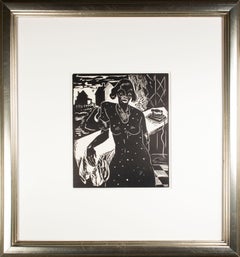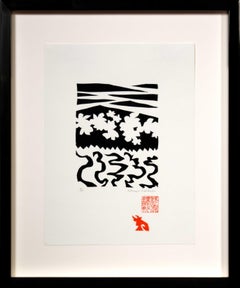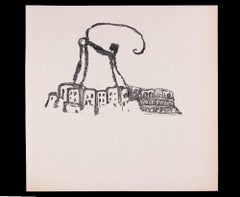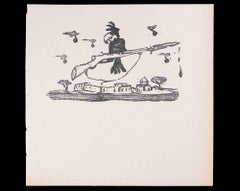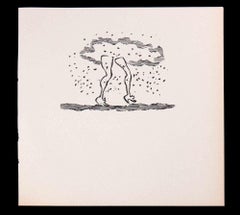Art by Medium: Linocut
to
32
115
44
41
5
2
Overall Width
to
Overall Height
to
1
197
9
6
32
18
57
28
11
11
10
422
207
107
55
23
18
14
7
7
5
2
1
136
65
6
104
48
43
36
36
33
30
23
16
10
10
9
7
7
5
5
5
5
4
4
1,197
10,612
10,485
9,882
5,703
60
14
11
9
5
30
93
104
59
Style: Modern
Medium: Linocut
'Flowers' original abstract linocut by Wisconsin artist Schomer Lichtner
Located in Milwaukee, WI
'Flowers' is an original linocut by Wisconsin-based artist Schomer Lichtner. The composition presents a scattered floral still life amongst abstracted shadows and forms, rendered with Lichtner's quintessential abstract sensibilities. This print is one from a series that each depict abstracted subjects in black silhouette, taking pleasure in the materiality of the linocut technique. The free forms of the flower resemble the lyrical mid-century works of the French artist Henri Matisse, which combined with these material concerns demonstrate Lichter's modern sensibilities. The prints from this series are unusual because of how below the image, Lichtner also includes his Chinese seal and a linocut remarque of a cow, each of which act as an additional signature of the artist on the artwork.
Linocut in black and red on Permalife white wove paper
4 x 5.25 inches, image
11.5 x 8.75 inches, sheet
16.5 x 13.63 inches, frame
Signed in pencil, below image, lower right.
Edition 1/100 in pencil, below image, lower left.
Chinese signature stamp in red, below image, lower right.
Remaque of a cow in red, below image, lower right.
Permalife watermark to paper.
Framed to conservation standards in a shadow-box style mounting, using 100 percent rag matting, museum glass, and housed in a silver-finish wood moulding.
Overall excellent condition with no creases or discoloration.
Milwaukee artist Schomer Lichtner was well known for his whimsical cows and ballerinas and abstract imagery. He and his late wife Ruth Grotenrath, both well-known Wisconsin artists, began their prolific careers as muralists for WPA projects, primarily post offices.
Lichtner also painted murals for industry and private clients. Schomer was a printmaker and produced block prints, lithographs, and serigraph prints. His casein (paint made from dairy products) and acrylic paintings are of the rural Wisconsin landscape and farm animals. He became interested in cows when he and Ruth spent summers near Holy Hill in Washington County. According to David Gordon, director of the Milwaukee Art Museum, Schomer Lichtner had a tremendous joie de vivre and expressed it in his art.
Schomer Lichtner was nationally known for his whimsical paintings and sculptures of black- and white-patterned Holstein cows...
Category
Late 20th Century American Modern Art by Medium: Linocut
Materials
Paper, Black and White, Linocut
'Monday in Wick Haven' original linoleum cut print by Howard Thomas
Located in Milwaukee, WI
In this image, Howard Thomas presents the viewer with a domestic interior. The image is dominated by the figure of a black woman, resting her arm on an ironing board. To the right, the tool of her task dangles a chord above a checker tiled floor. Beyond, though a window, neighboring homes fill the landscape. The careful line-work of the linocut adds a sense of expressionism to the scene, but the image nonetheless falls into the Social Realism that captivated most American artists during the Great Depression.
This print was published in 1936 as part of the Wisconsin Artists' Calendar for the year 1937, which included 52 original, hand-made prints – one for each week of the year.
6 x 5 inches, image
10 x 7.13 inches, sheet
12.37 x 12.43 inches, frame
Entitled "Monday in Wick Haven" lower left (covered by matting)
Inscribed "Linoleum Cut" lower center (covered by matting)
Artist name "Howard Thomas" lower right (covered by matting)
Framed to conservation standards using 100 percent rag matting and museum glass, all housed in a silver gilded moulding.
Quaker-born in Ohio, Thomas trained in the Midwest at Ohio State University and the Chicago Art Institute. He taught in the Art Department of the Milwaukee State Teachers College (now University of Wisconsin-Milwaukee) where he became good friends with Carl Holty, Edward Boerner, Robert von Neumann...
Category
1930s American Modern Art by Medium: Linocut
Materials
Linocut
'Field' original abstract linocut in black by Wisconsin artist Schomer Lichtner
Located in Milwaukee, WI
'Field' is an original linocut by Wisconsin-based artist Schomer Lichtner. The composition presents fields of flowers, trees and grasses below a cloudy sky, but rendered with Lichtner's quintessential abstract sensibilities. This print is one from a series that each depict abstracted subjects in black silhouette, taking pleasure in the materiality of the linocut technique. The free forms of the plants resemble the lyrical mid-century works of the French artist Henri Matisse, which combined with these material concerns demonstrate Lichter's modern sensibilities. The prints from this series are unusual because of how below the image, Lichtner also includes his Chinese seal and a linocut remarque of a cow, each of which act as an additional signature of the artist on the artwork.
Linocut in black and red on Permalife white wove paper
4.5 x 6 inches, image
11.5 x 8.75 inches, sheet
16.5 x 13.63 inches, frame
Signed in pencil, below image, lower right.
Edition 1/100 in pencil, below image, lower left.
Chinese signature stamp in red, below image, lower right.
Remaque of a cow in red, below image, lower right.
Permalife watermark to paper.
Framed to conservation standards in a shadow-box style mounting, using 100 percent rag matting, museum glass, and housed in a silver-finish wood moulding.
Overall excellent condition with no creases or discoloration.
Milwaukee artist Schomer Lichtner was well known for his whimsical cows and ballerinas and abstract imagery. He and his late wife Ruth Grotenrath, both well-known Wisconsin artists, began their prolific careers as muralists for WPA projects, primarily post offices.
Lichtner also painted murals for industry and private clients. Schomer was a printmaker and produced block prints, lithographs, and serigraph prints. His casein (paint made from dairy products) and acrylic paintings are of the rural Wisconsin landscape and farm animals. He became interested in cows when he and Ruth spent summers near Holy Hill in Washington County. According to David Gordon, director of the Milwaukee Art Museum, Schomer Lichtner had a tremendous joie de vivre and expressed it in his art.
Schomer Lichtner was nationally known for his whimsical paintings and sculptures of black- and white-patterned Holstein cows...
Category
Late 20th Century American Modern Art by Medium: Linocut
Materials
Black and White, Paper, Linocut
The City Dominator - Linocut by Mino Maccari - 1951
By Mino Maccari
Located in Roma, IT
The City Dominator is an original Linocut Print realized by Mino Maccari in 1951.
Very Good condition.
No Signature.
Mino Maccari (1898-1989) was an Italian writer, painter, engra...
Category
1950s Modern Art by Medium: Linocut
Materials
Linocut
The Gunner Bird - Linocut by Mino Maccari - 1951
By Mino Maccari
Located in Roma, IT
The Gunner Bird is an original Linocut Print realized by Mino Maccari in 1951.
Very Good condition.
No Signature.
Mino Maccari (1898-1989) w...
Category
1950s Modern Art by Medium: Linocut
Materials
Linocut
Mystical Legs - Linocut by Mino Maccari - 1951
By Mino Maccari
Located in Roma, IT
Mystical Legs is an original Linocut Print realized by Mino Maccari in 1951.
Very Good condition.
No Signature.
Mino Maccari (1898-1989) was an Italian writer, painter, engraver a...
Category
1950s Modern Art by Medium: Linocut
Materials
Linocut
A Rooster on The Head - Linocut by Mino Maccari - 1951
By Mino Maccari
Located in Roma, IT
A Rooster n The Head is an original Linocut Print realized by Mino Maccari in 1951.
Very Good condition.
No Signature.
Mino Maccari (1898-1989) was an Italian writer, painter, eng...
Category
1950s Modern Art by Medium: Linocut
Materials
Linocut
The Ant and The Butterfly - Linocut by Mino Maccari - 1951
By Mino Maccari
Located in Roma, IT
The Ant and The Butterfly is an original Linocut Print realized by Mino Maccari in 1951.
Very Good condition.
No Signature.
Mino Maccari (1898-1989) was an Italian writer, painter...
Category
1950s Modern Art by Medium: Linocut
Materials
Linocut
The Domestic Crocodile - Linocut by Mino Maccari - 1951
By Mino Maccari
Located in Roma, IT
The Domestic Crocodile is an Original Linocut Print realized by mino Maccari in 1951.
Not signed, very good condition.
Mino Maccari (1898-1989) was an Italian writer, painter, eng...
Category
1950s Modern Art by Medium: Linocut
Materials
Linocut
The Painted Tree - Linocut by Mino Maccari - 1951
By Mino Maccari
Located in Roma, IT
The Painted Tree is an Original Linocut Print realized by mino Maccari in 1951.
Not signed, very good condition.
Mino Maccari (1898-1989) was an Italian writer, painter, engraver ...
Category
1950s Modern Art by Medium: Linocut
Materials
Linocut
The Hen Hat - Original Linocut by Mino Maccari - 1951
By Mino Maccari
Located in Roma, IT
The Hen Hat is an original Linocut Print realized by Mino Maccari in 1951.
Very Good condition.
No Signature.
Mino Maccari (1898-1989) was an Italian writer, painter, engraver and...
Category
1950s Modern Art by Medium: Linocut
Materials
Linocut
The Wake - Original Linocut by Mino Maccari - 1951
By Mino Maccari
Located in Roma, IT
The Wake is an original Linocut Print realized by Mino Maccari in 1951.
Very Good condition.
No Signature.
Mino Maccari (1898-1989) was an Italian writer, painter, engraver and jo...
Category
1950s Modern Art by Medium: Linocut
Materials
Linocut
Gentledogs - Original Linocut by Mino Maccari - 1951
By Mino Maccari
Located in Roma, IT
Gentledogs is an original Linocut Print realized by Mino Maccari in 1951.
Very Good condition.
No Signature.
Mino Maccari (1898-1989) was an Italian writer, painter, engraver and ...
Category
1950s Modern Art by Medium: Linocut
Materials
Linocut
"Hotel Lobby, " Linoleum Cut by Alexander Tillotson
Located in Milwaukee, WI
"Hotel Lobby" is a linoleum print by Alexander Tillotson. It features the view of a hotel lobby from the viewpoint of the back of two men. Thick lines and minimal negative space give...
Category
1930s American Modern Art by Medium: Linocut
Materials
Linocut
"Noel, " Religious Linocut on Blue Paper stamped signature by Sylvia Spicuzza
Located in Milwaukee, WI
"Noel" is an original linocut on blue paper by Sylvia Spicuzza. The artist stamped her signature lower center. This artwork features the Virgin Mary holding the baby Jesus. Both figu...
Category
1950s American Modern Art by Medium: Linocut
Materials
Linocut
"Noel, " Relief Print signed by Sylviz Spicuzza
Located in Milwaukee, WI
"Noel" is an original relief print by Sylvia Spicuzza. A holiday themed print, this features the image of the virgin Mary and baby Jesus.
Image: 4" x 3"
...
Category
Late 20th Century American Modern Art by Medium: Linocut
Materials
Linocut
"Country Church, " Town Landscape Linoleum Cut by Elsa E. Ulbricht
Located in Milwaukee, WI
"Country Church" is an original linoleum print by Elsa E. Ulbricht. A front facing view of a country church is proudly replicated within this print.
Unsigned and unnumbered, as issued.
Image:7" x 5"
Framed: 15.25" x 13.25"
Painter, Teacher When she directed The Milwaukee Handicraft Project, Elsa Ulbricht...
Category
1930s American Modern Art by Medium: Linocut
Materials
Linocut
"Greetings, 'Starflower, '" Linocut with White Ink on Blue Paper by S. Spicuzza
Located in Milwaukee, WI
"Greetings, 'Starflower'" is a linocut with white ink on blue paper by Sylvia Spicuzza. A smiling star is centered in the piece with Greetings written bellow them.
Art: 4.88 x 3.88 ...
Category
1950s Modern Art by Medium: Linocut
Materials
Linocut
Balance #3, Hand Printed Work, Linocut
By Stacy Rajab
Located in Yardley, PA
A black large-scale linocut print with blue highlights. This design uses linocut blocks to come up with the perfect color block art. This modern linocu...
Category
21st Century and Contemporary Modern Art by Medium: Linocut
Materials
Linocut
"Noel, " Religious Linocut in Blue on Tissue Paper signed by Sylvia Spicuzza
Located in Milwaukee, WI
"Noel" is an original linocut on tissue paper by Sylvia Spicuzza. The artist stamped her signature lower right. This artwork features the Virgin Mary holding the baby Jesus. Both fig...
Category
1950s American Modern Art by Medium: Linocut
Materials
Linocut
UNA ROSA, UNA SPERANCA.
Located in Portland, ME
Bethol. UNA ROSA, UNA SPERANCA. Linocut, 1962. Edition of 21. Signed, titled, dated and numbered "21/20" in pencil. Printed on thin tissue. 20 1/2 x 23 3/4 inches, plus margins. In v...
Category
1960s Modern Art by Medium: Linocut
Materials
Linocut
"Rest, " Farmer leaning on Work Tool Linoleum Cut signed by Schomer Lichtner
Located in Milwaukee, WI
"Rest" is an original linoleum print by Schomer Lichtner, signed in the lower right hand corner. It features a man in the act of resting on a stick in the middle of work.
Image: 5.6...
Category
1930s American Modern Art by Medium: Linocut
Materials
Linocut
Tetes: Le Vieux Buffon (Bloch 1104), Signed Picasso Linocut
Located in New York, NY
Linoleum cut printed in colours, 1963, on Arches woven paper, signed in pencil and numbered 30/50. Printed by Hidalgo Arnéra, and published by Galerie Louise Leiris, Paris.
Category
1960s Modern Art by Medium: Linocut
Materials
Linocut
Then Came a Stick and Beat the Dog, 1984
By Frank Stella
Located in Palo Alto, CA
Then Came a Stick and Beat the Dog, 1984 is a stellar example of his use of incredibly bright colors and a plethora of irregular shapes. The first thing you notice about this piece besides its colossal size is the color palette. The colors are highly saturated and vibrant; they carry a certain narrative, heavy quality that speaks to you. To name a few, Stella uses electrifying colors of magenta, pink, silver, brown, green, lavender, and aquamarine. These hues dazzle in plain sight but also accentuate the disorderly shapes of cones and cylinders. The outlines of these forms spill over the edge of the paper while the magical swirls of lines occupy your vision. The diversity in texture and layering of color on top of each other heightens the sense of mass and weight incorporated into this work.
The rhythmic lines and experimental quality of irregular shapes compose a kind of poetic allure. Inspired by gouaches done by the Russian avant-garde artist, El Lissitsky, Stella takes on a fresh new rendition. El Lissitzky’s works that Stella had seen in Tel Aviv were based on a song called “Had Gadya.” Stella designated titles for each variant in the series that becomes very much a part of his style as an artist. This piece is an example that highlights Stella as an artist who fuses inspiration from his well-traveled life into an aesthetically and culturally pleasing work of art. In all of this work’s interwoven structures, layered colors, and historic background, lies the mastery of Frank Stella, as a distinct artist in his ability to combine a vast array of elements.
Created in 1984, Then Came a Stick and Beat the Dog, 1984 from Illustrations After El Lissitzky's Had Gadya is a hand-coloring and collage with lithograph, linocut, and silkscreen on T. H. Saunders paper (background) and shaped, hand-cut Somerset paper (collage). Hand-signed and dated by Frank Stella (Massachusetts, 1936 - ) in pencil in the lower left: ‘F. Stella ‘84’, this work is numbered from the edition of 60 in pencil in the left; published by Waddington Graphics, London.
Catalogue Raisonné & COA:
Frank Stella Then Came...
Category
1980s Modern Art by Medium: Linocut
Materials
Lithograph, Linocut, Screen
Price Upon Request
Satyr, Nymph and Cupid (Tropic of Cancer), Linocut by Benno 1935
Located in Long Island City, NY
A risquee Modern print depicting a Cupid observing his good work on a Satyr & Nymph. The Bacchanalia has reached it's desired conclusion. This is an original 1935 linocut print on wo...
Category
1930s Modern Art by Medium: Linocut
Materials
Linocut
Man
Located in Missouri, MO
Elizabeth Catlett
“Man” 1975 (The Print Club of Cleveland Publication Number 83, 2005)
Woodcut and Color Linocut
Printed in 2003 at JK Fine Art Editions Co., Union City, New Jersey
Signed and Dated By The Artist Lower Right
Titled Lower Left
Ed. of 250
Image Size: approx 18 x 12 inches
Elizabeth Catlett (1915-2012) is regarded as one of the most important women artists and African American artists of our time. She believed art could affect social change and that she should be an agent for that change: “I have always wanted my art to service black people—to reflect us, to relate to us, to stimulate us, to make us aware of our potential.” As an artist and an activist, Catlett highlighted the dignity and courage of motherhood, poverty, and the working class, returning again and again to the subject she understood best—African American women.
The work below, entitled, “Man”, is "carved from a block of wood, chiseled like a relief. Catlett, a sculptor as well as a printmaker, carves figures out of wood, and so is extremely familiar with this material. For ‘Man’ she exploits the grain of the wood, allowing to to describe the texture of the skin and form vertical striations, almost scarring the image. Below this intense, three-dimensional visage parades seven boys, printed repetitively from a single linoleum block in a “rainbow roll” that changes from gold to brown. This row of brightly colored figures with bare feet, flat like a string of paper dolls, raise their arms toward the powerful depiction of the troubled man above.”
Biography:
Elizabeth Catlett (1915-2012)
Known for abstract sculpture in bronze and marble as well as prints and paintings, particularly depicting the female figure, Elizabeth Catlett is unique for distilling African American, Native American, and Mexican art in her work. She is "considered by many to be the greatest American black sculptor". . .(Rubinstein 320)
Catlett was born in Washington D.C. and later became a Mexican citizen, residing in Cuernavaca Morelos, Mexico. She spent the last 35 years of her life in Mexico.
Her father, a math teacher at Tuskegee Institute in Alabama, died before she was born, but the family, including her working mother, lived in the relatively commodious home of his family in DC. Catlett received a Bachelor of Arts degree from Howard University, where there was much discussion about whether or not black artists should depict their own heritage or embrace European modernism.
She earned a Master of Fine Arts degree in 1940 from the University of Iowa, where she had gone to study with Grant Wood, Regionalist* painter. His teaching dictum was "paint what you know best," and this advice set her on the path of dealing with her own background. She credits Wood with excellent teaching and deep concern for his students, but she had a problem during that time of taking classes from him because black students were not allowed housing in the University's dormitories.
Following graduation in 1940, she became Chair of the Art Department at Dillard University in New Orleans. There she successfully lobbied for life classes with nude models, and gained museum admission to black students at a local museum that to that point, had banned their entrance. That same year, her painting Mother and Child, depicting African-American figures won her much recognition.
From 1944 to 1946, she taught at the George Washington Carver School, an alternative community school in Harlem that provided instruction for working men and women of the city. From her experiences with these people, she did a series of paintings, prints, and sculptures with the theme "I Am a Negro Woman."
In 1946, she received a Rosenwald Fellowship*, and she and her artist husband, Charles White, traveled to Mexico where she became interested in the Mexican working classes. In 1947, she settled permanently in Mexico where she, divorced from White, married artist Francisco Mora...
Category
Late 19th Century American Modern Art by Medium: Linocut
Materials
Linocut, Woodcut
Price Upon Request
Diurnes (Femme Assise En Pyjama De Plage II)
Located in Missouri, MO
Pablo Picasso
"Diurnes" (Femme Assise En Pyjama De Plage II) 1962
Linocut printed in ochre and brown, 1962, on Arches paper
Inscribed "Epreuve D'Artist" (Artist Proof) lower left, as...
Category
1960s Modern Art by Medium: Linocut
Materials
Linocut
Price Upon Request
Linocut art for sale on 1stDibs.
Find a wide variety of authentic Linocut art available on 1stDibs. While artists have worked in this medium across a range of time periods, art made with this material during the 21st Century is especially popular. If you’re looking to add art created with this material to introduce a provocative pop of color and texture to an otherwise neutral space in your home, the works available on 1stDibs include elements of blue, purple, orange, green and other colors. There are many well-known artists whose body of work includes ceramic sculptures. Popular artists on 1stDibs associated with pieces like this include Mino Maccari, (after) Pablo Picasso, Rob Barnes, and Pablo Picasso. Frequently made by artists working in the Contemporary, Modern, all of these pieces for sale are unique and many will draw the attention of guests in your home. Not every interior allows for large Linocut art, so small editions measuring 0.01 inches across are also available

